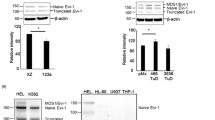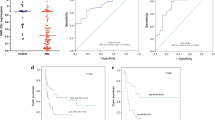Abstract
Purpose
High expression of ecotropic viral integration site 1 (EVI1) has been associated with a poor prognosis in leukemia patients, but the underlying mechanism remains unclear. Aberrant expression of microRNAs plays critical roles in leukemia development. MiR-9 is a putative potential target of EVI1. We have investigated the regulating mechanism of miR-9 by EVI1 in leukemia cells.
Methods
We first examined the relationship between miR-9 and EVI1 expression levels in nine leukemia cell lines by RT-PCR. Then we forced high expression of EVI1 in UoCM1 and K562 cells to confirm the downregulation of miR-9 by EVI1. Methylation of the miR-9 promoter region was detected by DNA bisulfite sequencing. We treated the EVI1-overexpressing cells with the hypomethylating agent 5-aza-2′-deoxycytidine (5-AZA) to reverse EVI1-induced hypermethylation of miR-9.
Results
EVI1 and miR-9 expression was negative related. Forced expression of EVI1 downregulated miR-9 by inducing hypermethylation of the miR-9 promoter. 5-AZA reversed high EVI1-induced hypermethylation of the miR-9 promoter and restored the expression of miR-9. 5-AZA induced extensive apoptosis and inhibited proliferation through cell cycle arrest in EVI1-overexpressing leukemia cells.
Conclusions
Our results suggest that EVI1 may be involved in leukemia cell proliferation and apoptosis via the regulation of miR-9 promoter methylation. 5-AZA may represent a promising therapeutic option for EVI1-high leukemia patients.




Similar content being viewed by others
References
Mucenski ML, Taylor BA, Ihle JN, et al. Identification of a common ecotropic viral integration site, Evi-1, in the DNA of AKXD murine myeloid tumors. Mol Cell Biol. 1988;8(1):301–8.
Hoyt PR, Bartholomew C, Davis AJ, et al. The Evil proto-oncogene is required at midgestation for neural, heart, and paraxial mesenchyme development. Mech Dev. 1997;65:55–70.
Nucifora G, Laricchia-Robbio L, Senyuk V. EVI1 and hematopoietic disorders: history and perspectives. Gene. 2006;368:1–11.
Lawce H, Szabo E, Torimaru Y, et al. MECOM (EVI1) rearrangements: a review and case report of two MDS patients with complex 3q inversion/deletions. J Assoc Genet Technol. 2017;43(1):9–14.
Goyama S, Kurokawa M. Pathogenetic significance of ecotropic viral integration site-1 in hematological malignancies. Cancer Sci. 2009;100:990–5.
Balgobind B, Lugthart S, Hollink I, et al. EVI1 overexpression in distinct subtypes of pediatric acute myeloid leukemia. Leukemia. 2010;24(5):942–9.
Lugthart S, Gröschel S, Beverloo HB, et al. Clinical, molecular, and prognostic significance of WHO type inv (3)(q21q26.2)/t (3;3)(q21; q26.2) and various other 3q abnormalities in acute myeloid leukemia. J Clin Oncol. 2010; 28:3890–98.
Van Doorn SBVW, Erpelinck C, van Putten WL, et al. High EVI1 expression predicts poor survival in acute myeloid leukemia: a study of 319 de novo AML patients. Blood. 2003;101:837–45.
Gröschel S, Lugthart S, Schlenk RF, et al. High EVI1 expression predicts outcome in younger adult patients with acute myeloid leukemia and is associated with distinct cytogenetic abnormalities. J Clin Oncol. 2010;28:2101–7.
Zhao H, Wang D, Du W, et al. MicroRNA and leukemia: tiny molecule, great function. Crit Rev Oncol Hematol. 2010;74:149–55.
Schotte D, Pieters R, Den Boer M. MicroRNAs in acute leukemia: from biological players to clinical contributors. Leukemia. 2012;26:1–12.
Emmrich S, Katsman-Kuipers J, Henke K, et al. miR-9 is a tumor suppressor in pediatric AML with t (8; 21). Leukemia. 2014;28:1022–32.
Senyuk V, Zhang Y, Liu Y, et al. Critical role of miR-9 in myelopoiesis and EVI1-induced leukemogenesis. Proc Natl Acad Sci USA. 2013;110(14):5594–99
Phillips CL, Davies SM, Mcmasters R, et al. Low dose decitabine in very high risk relapsed or refractory acute myeloid leukaemia in children and young adults. Br J Haematol. 2013;161:406–10.
Haas K, Kundi M, Sperr WR, et al. Expression and prognostic significance of different mRNA 5'-end variants of the oncogene EVI1 in 266 patients with de novo AML: EVI1 and MDS1/EVI1 overexpression both predict short remission duration. Genes Chromosomes Cancer. 2008;47:288–98.
Dreyfus F, Bouscary D, Melle J, et al. Expression of the Evi-1 gene in myelodysplastic syndromes. Leukemia. 1995;18:203–5.
Sato T, Goyama S, Kataoka K, et al. Evi1 defines leukemia-initiating capacity and tyrosine kinase inhibitor resistance in chronic myeloid leukemia. Oncogene. 2014;33:5028–38.
Laricchia-Robbio L, Fazzina R, Li D, et al. Point mutations in two EVI1 Zn fingers abolish EVI1-GATA1 interaction and allow erythroid differentiation of murine bone marrow cells. Mol Cell Biol. 2006;26:7658–66.
Senyuk V, Sinha KK, Li D, et al. Repression of RUNX1 activity by EVI1: a new role of EVI1 in leukemogenesis. Cancer Res. 2007;67:5658–66.
Laricchiarobbio L, Premanand K, Rinaldi CR, et al. EVI1 Impairs myelopoiesis by deregulation of PU.1 function. Cancer Res. 2009;69:1633–42.
Lugthart S, Figueroa ME, Bindels E, et al. Aberrant DNA hypermethylation signature in acute myeloid leukemia directed by EVI1. Blood. 2011;117:234–41.
Yoshimi A, Goyama S, Watanabe-Okochi N, et al. Evi1 represses PTEN expression and activates PI3K/AKT/mTOR via interactions with polycomb proteins. Blood. 2011;117:3617–28.
Glass C, Wilson M, Gonzalez R, et al. The role of EVI1 in myeloid malignancies. Blood Cells Mol Dis. 2014;53:67–76.
Saito Y, Jones PA. Epigenetic activation of tumor suppressor microRNAs in human cancer cells. Cell Cycle. 2006;5:2220–2.
Nie K, Gomez M, Landgraf P, et al. MicroRNA-mediated down-regulation of PRDM1/Blimp-1 in hodgkin/reed-sternberg cells: a potential pathogenetic lesion in hodgkin lymphomas. Am J Pathol. 2008;173:242–52.
Li Y, Zhao L, Li N, et al. miR-9 regulates the multidrug resistance of chronic myelogenous leukemia by targeting ABCB1. Oncol Rep. 2017;37:2193–200.
Weidner H, Bill M, Schmalbrock L, et al. High expression of Mir-9 down-regulates the poor outcome prognosticator ERG and associates with reduced relapse-rates in acute myeloid leukemia. Blood. 2014;124:1575–1575.
Nowek K, Sun SM, Dijkstra MK, et al. Expression of a passenger miR-9 predicts favorable outcome in adults with acute myeloid leukemia less than 60 years of age. Leukemia. 2015;30:303–9.
Herman JG, Baylin SB. Gene silencing in cancer in association with promoter hypermethylation. N Engl J Med. 2003;349:2042–54.
Funding
This work was supported by Advanced Suitable Technology Popularization Project of Shanghai Health System (Grant no. 2013SY073).
Author information
Authors and Affiliations
Corresponding author
Ethics declarations
Conflict of interest
The authors declare no conflicts of interest.
Ethical approval
This article does not contain any studies with human participants or animals performed by any of the authors.
Informed consent
This article does not contain any studies with human participants performed by any of the authors. Therefore, informed consent is not included.
Additional information
Publisher's Note
Springer Nature remains neutral with regard to jurisdictional claims in published maps and institutional affiliations.
Rights and permissions
About this article
Cite this article
Li, F., He, W., Geng, R. et al. Myeloid leukemia with high EVI1 expression is sensitive to 5-aza-2′-deoxycytidine by targeting miR-9. Clin Transl Oncol 22, 137–143 (2020). https://doi.org/10.1007/s12094-019-02121-y
Received:
Accepted:
Published:
Issue Date:
DOI: https://doi.org/10.1007/s12094-019-02121-y




